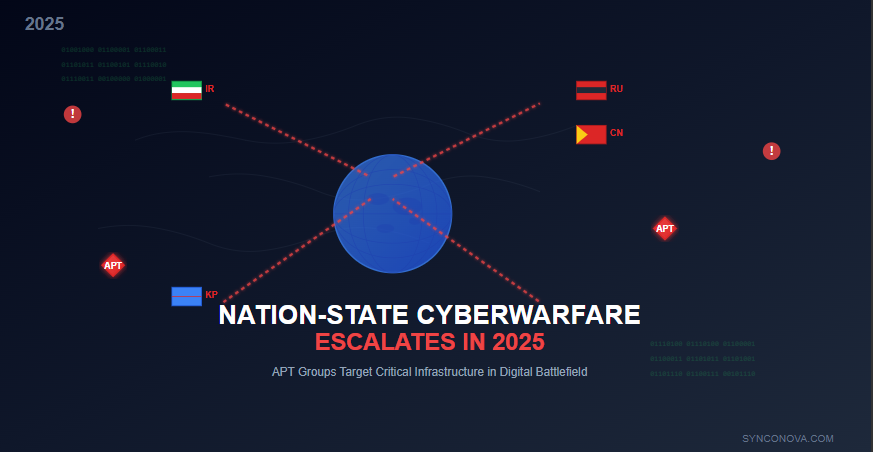The cyber domain has become the primary theatre for international conflict, and 2025 has witnessed an unprecedented escalation in nation-state cyberwarfare. Recent intelligence reports paint a sobering picture: state-sponsored Advanced Persistent Threat (APT) groups are becoming more sophisticated, more aggressive, and increasingly targeting critical infrastructure that underpins modern society.
For businesses operating in this volatile digital landscape, understanding these evolving threats isn’t just about cybersecurity—it’s about business continuity and national security.
The Numbers Don’t Lie: Cyberwarfare is Surging
The scale of nation-state cyberwarfare in 2025 is staggering. Russian cyberattacks on Ukraine surged by nearly 70% in 2024, with 4,315 incidents targeting critical infrastructure, including government services, the energy sector, and defense-related entities. Meanwhile, Taiwanese government networks experienced double the number of daily attacks in 2024 compared to 2023, most of which were attributed to Chinese state-backed hackers, with attacks reaching 2.4 million daily attempts.
These aren’t isolated incidents—they represent a fundamental shift in how nations project power and pursue strategic objectives.
The Big Players: APT Groups Dominating 2025
North Korea’s Lazarus Group: Financial Warfare Perfected
The Lazarus Group, a North Korean state-sponsored APT, is one of the most notorious cyber adversaries, known for its espionage, financial theft, and disruptive attacks. What makes Lazarus particularly dangerous in 2025 is their evolution from simple financial theft to sophisticated supply chain attacks that can cripple entire sectors.
Their latest campaigns target cryptocurrency exchanges, financial institutions, and even healthcare systems to fund North Korea’s weapons programmes whilst gathering intelligence on international sanctions evasion.
Chinese APT Groups: The Long Game
Chinese state-sponsored groups have intensified their focus on intellectual property theft and critical infrastructure mapping. Their approach in 2025 demonstrates remarkable patience—establishing persistent access to systems years before activation, creating a vast network of compromised assets ready for future conflicts.
Iranian Cyber Units: Destructive and Disruptive
Void Manticore (aka Storm-842) is an Iranian state-sponsored threat actor notorious for conducting destructive attacks on Israeli organizations and leaking information through the online persona ‘Karma’. Iranian groups have expanded beyond regional targets, now threatening global energy infrastructure and financial systems.
The Blurring Lines: APTs Meet Ransomware
A particularly concerning trend in 2025 is the blurring of lines between cybercrime and state-sponsored attacks. Nation-state actors are increasingly deploying ransomware not just for financial gain, but as a tool of statecraft—disrupting adversary operations whilst maintaining plausible deniability.
This hybrid approach makes attribution more difficult and response more complex, as traditional cybercrime and warfare tactics merge into something entirely new.
AI-Powered Threats: The Force Multiplier
In 2025, the world will increasingly face cybercrime driven by AI, generative AI and deepfakes. Nation-state actors are leveraging artificial intelligence to:
- Automate reconnaissance across millions of potential targets
- Generate convincing phishing content in multiple languages
- Create sophisticated deepfakes for social engineering
- Accelerate malware development and evasion techniques
The combination of state resources with AI capabilities creates threat actors more dangerous than ever before.
Critical Infrastructure: The Primary Target
Nation-state cyberwarfare in 2025 focuses heavily on critical infrastructure sectors that can cause maximum disruption:
- Energy grids and power stations – Creating cascading failures across regions
- Water treatment facilities – Threatening public health and safety
- Transportation networks – Disrupting logistics and emergency response
- Financial systems – Destabilising economic confidence
- Healthcare infrastructure – Compromising patient care and data
- Telecommunications – Cutting communication lines during crises
The targeting of these sectors represents a shift from espionage to preparation for potential kinetic conflict.
What This Means for UK Businesses
The escalation of nation-state cyberwarfare creates unprecedented risks for British businesses:
Supply Chain Vulnerabilities: Your third-party suppliers may already be compromised by state actors seeking to reach your systems indirectly.
Critical Infrastructure Dependencies: Even if your business isn’t directly targeted, cyberattacks on national infrastructure can severely impact operations.
Intellectual Property Theft: Nation-states are increasingly targeting private sector innovation, particularly in technology, defence, and renewable energy sectors.
Regulatory Compliance: As cyber threats evolve, so do regulatory requirements. The UK’s cybersecurity regulations are becoming more stringent in response to nation-state threats.
Advanced Protection Strategies
Traditional cybersecurity approaches are insufficient against nation-state cyberwarfare. Modern businesses need:
Zero Trust Architecture: Assume breach scenarios and verify every access request, regardless of source.
Threat Intelligence Integration: Real-time awareness of APT group activities and tactics targeting your sector.
Incident Response Planning: Rapid response capabilities designed for state-level adversaries, not just common cybercriminals.
Supply Chain Security: Comprehensive vetting and monitoring of all third-party connections and software dependencies.
Continuous Monitoring: 24/7 surveillance for indicators of APT group presence and lateral movement.
The Future of Digital Conflict
As we progress through 2025, nation-state cyberwarfare will likely intensify further. The convergence of AI, quantum computing advances, and increasing international tensions creates a perfect storm for cyber conflict.
Businesses that prepare now—with expert guidance and comprehensive cybersecurity strategies—will be best positioned to survive and thrive in this new digital battleground.
The question isn’t whether your organisation will be affected by nation-state cyber activities, but when—and whether you’ll be prepared.
Stay Ahead of Nation-State Threats
The escalation of nation-state cyberwarfare requires more than standard cybersecurity measures. It demands expert analysis, proactive threat hunting, and defence strategies specifically designed to counter APT group tactics.
Contact our cybersecurity specialists to assess your organisation’s resilience against nation-state threats and develop comprehensive protection strategies tailored to the current threat landscape.
Synconova provides advanced cybersecurity solutions designed to protect against nation-state threats, APT groups, and sophisticated cyber warfare tactics. Our team combines deep technical expertise with real-time threat intelligence to keep your organisation secure in an increasingly dangerous digital world.
